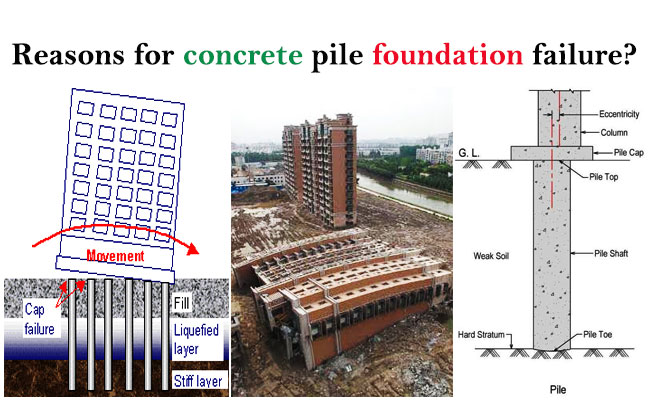Reasons for concrete pile foundation failure?

Pile foundation is extensively used in deep foundation type for civil structure. It can be easily adapted for complicated geologic settings and all types of load conditions, specifically for soft soil foundation. Pile foundation is mostly found in bridge engineering due to its strong bearing strength, proper solidity and little differential settlement with regards to other foundation types.
Several factors contribute to damages of bridge pile foundation under earthquake, soil conditions, extreme inertia force resulting from superstructure and improper design of piles.
Given below, the causes of pile failure:-
The rock stratum that supports piles should be adequately strong to retain the load transferred through pile tip devoid of failing in shear and settlement. Under such circumstance, the lean layer of sound rock overlapping unsound or fragile rock and deep pits or crevices in the rock surface impact the strong rock.
There should be adequate area of contact among the pile toe and the supporting stratum in order that the load from pile is transferred securely to the stratum underneath. Often, construction is done with faulty pile toe and/or inappropriate seating of pile toe over the supporting stratum. This situation causes extreme order of settlements. Sometimes, pile toe concrete surface partially gets in touch with the supporting stratum and as a result, under the design loads, huge intensities of stresses are formed in toe portion concrete that may crush and then cause unnecessary settlement of a pile.
Pile shaft body should perform as a solid column to transmit the load of the superstructure to the sustaining stratum. The faults in the cast-in-situ piles are occurred due to the effect of defective concreting. In some cases, application of harmful concrete materials, inaccurate mix designs etc. lead to a substandard quality of pile body.
Throughout construction, all the piles are placed eccentrically to some extent. The impact of eccentricities normally becomes higher when placed on hard stratum, or casing pipes are detached after concreting of piles, or the depth of piles change among 10 to 20 m, or during construction. The super-structural frame was tilted and got out of plumb by about 30cms.
When different destructive chemicals like water soluble chlorides and sulphates exist in subsoil water over allowable limits, they provide harmful effect on the cast-in-situ concrete and may decay the reinforcement of the pile body and produce an ineffective pile regarding function of load transition from the superstructure to hard stratum is involved.
Consolidating recent fills and clayey soils gradually produce a downward drag on the pile body. This negative drag becomes a major reason of failures of some pile developed in reclaimed areas.
Partition among pile cap and pile head because of shear and bending failures in pile head, and the insufficient (or missing) structural connecting measures.
Failure of the welded joint of pile cap owning to buckling damage of piles.
Girder falling because of the displacement of pier supported by pile foundation.
Failure of inclined pile. Bank soil shifts to the center of river that leads to torsional deformation in abutment.

